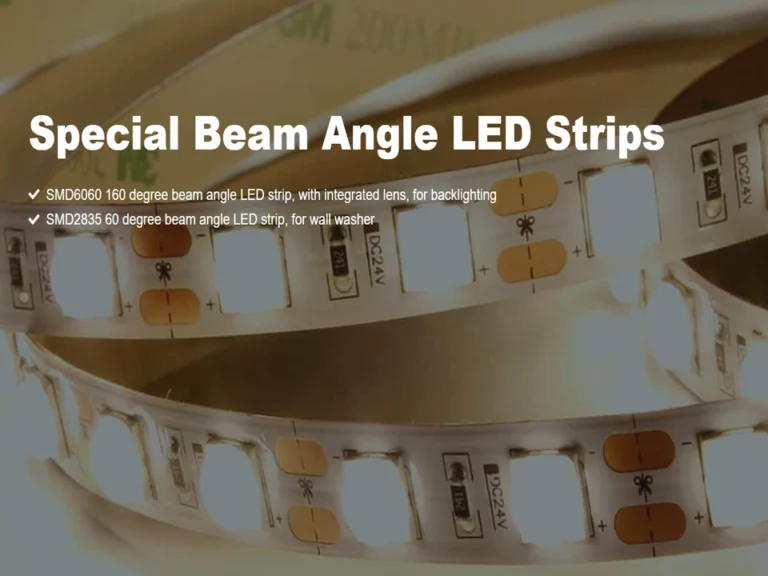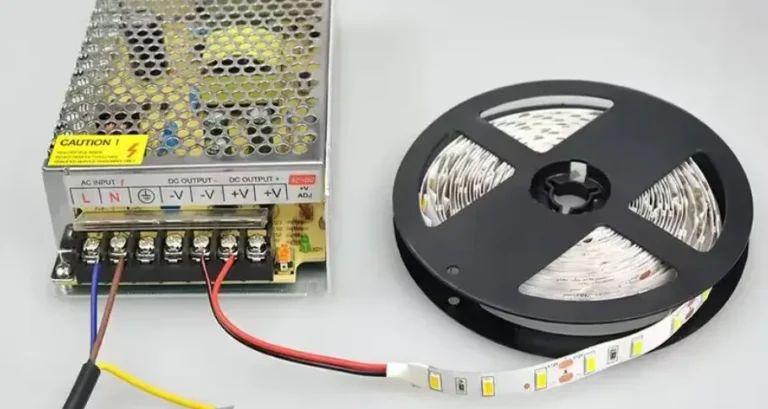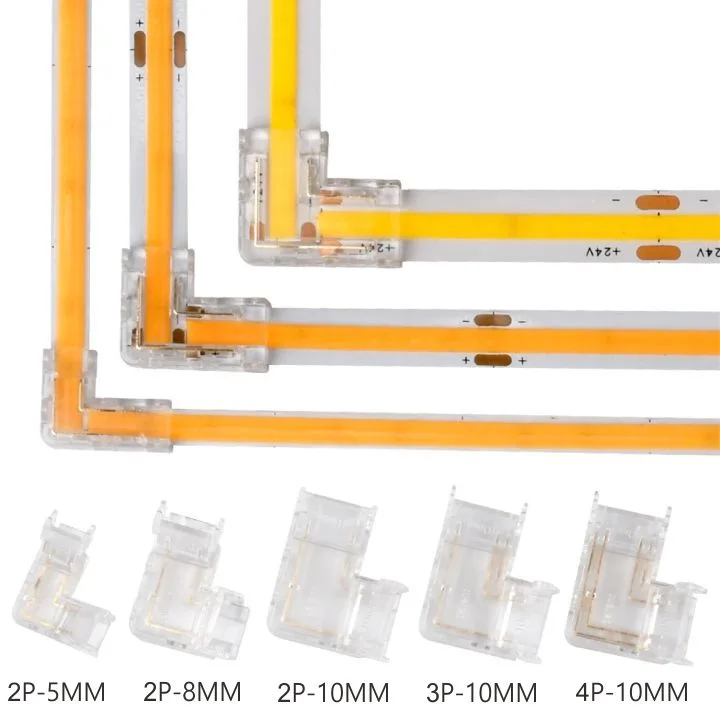In modern lighting projects, dimming has become a critical element for enhancing spatial ambiance and energy efficiency. While an increasing number of digital dimming protocols (such as DALI, 0-10V, and smart wireless controls) are now being adopted, TRIAC dimming remains the most common and widely used method globally.
Originally designed for dimming incandescent and halogen lamps, TRIAC (Triode for Alternating Current) has evolved alongside LED lighting. Manufacturers developed TRIAC-compatible LED drivers, enabling its continued use in modern lighting systems as LEDs replace traditional light sources. For scenarios extensively utilizing traditional dimmers, this dimming method helps projects strike a balance between cost control, ease of installation, and system compatibility.
However, TRIAC dimming is not without limitations. It presents challenges in areas such as compatibility with LED drivers, dimming range, and stability. Improper design or component selection may lead to issues like flickering, noise, or failure to start fixtures. Therefore, a thorough understanding of TRIAC dimming principles, advantages, and limitations is crucial for lighting engineers, distributors, and project managers.
This article systematically analyzes the working mechanism of TRIAC dimming, driver selection, pros and cons, common issues and solutions, and compares it with other mainstream dimming methods. It aims to help you make more appropriate technical decisions for your projects.
What is a TRIAC?
TRIAC stands for Triode for Alternating Current, specifically an AC three-terminal bidirectional thyristor. It is a semiconductor device capable of conducting current during both phases of an AC cycle (positive and negative half-cycles), making it particularly suitable for dimming and speed control applications in AC power sources.

In the lighting industry, TRIAC were first used for dimming incandescent and halogen lamps. By altering the conduction angle of the voltage waveform, TRIAC dimming effectively reduces the current flowing through the filament, thereby lowering brightness. This dimming method is simple and low-cost and can be easily implemented using traditional knobs or sliding dimmers.
The Basic Structure and Operation of TRIAC
- Three-terminal Sballing: The TRIAC features three terminals—Main Terminal 1 (MT1), Main Terminal 2 (MT2), and Gate.
- Bidirectional Conduction: Unlike unidirectional thyristors (SCR), TRIAC can be triggered to conduct during both the positive and negative half-cycles of an AC waveform.
- Phase Control: By controlling the timing of the TRIAC’s triggering within the AC waveform, the dimmer allows only a portion of the current to flow through the load (e.g., lighting fixtures), achieving brightness adjustment.
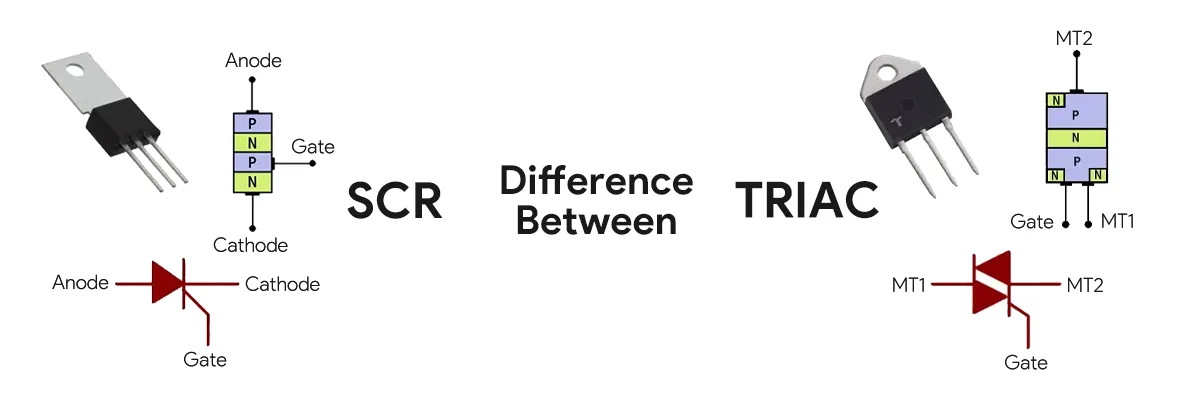
Leading Edge vs. Trailing Edge
TRIAC dimming methods are primarily divided into two types:
1. Leading Edge Dimming
- Cuts off current at the beginning of the AC waveform and conducts at a preset trigger point.
- Advantages: Mature technology, low cost.
- Disadvantages: Poor compatibility with LED drivers; may cause noise or flicker.
2. Trailing Edge Dimming
- Cuts off current during the latter half of the AC waveform, preserving the first half intact.
- Advantages: More compatible with electronic drivers, smoother dimming curves.
- Disadvantages: Higher cost, not supported by all legacy dimmers.
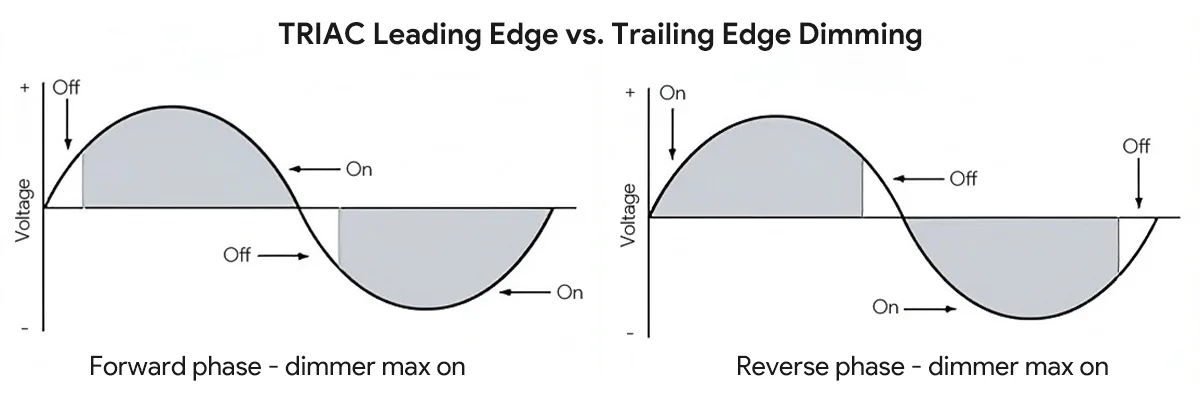
Significance in LED Lighting
Due to significant electrical differences between LEDs and incandescent lamps (e.g., lower power, non-resistive load, driver dependency), TRIAC dimming cannot be directly applied to LED fixtures. TRIAC-compatible LED drivers must be used to ensure smooth and stable dimming performance.
Therefore, in the LED lighting field, “TRIAC dimming” typically refers to the combination of a “TRIAC dimmer + TRIAC-compatible LED driver,” not the TRIAC device alone.
What is Triac Dimming?
When TRIACs are applied to LED lighting applications, they are commonly referred to as TRIAC dimming. The advantages of triac dimming include high efficiency, stable performance, and low dimming costs. TRIAC dimming typically requires a TRIAC dimmer to implement and sometimes also necessitates a TRIAC-dimmable LED driver to control LED lamps or LED strips.
For more information on dimming LED strip lights, read the blog post “Hoe u LED-striplichten dimt: een uitgebreide gids voor dimmethoden en compatibiliteit.”
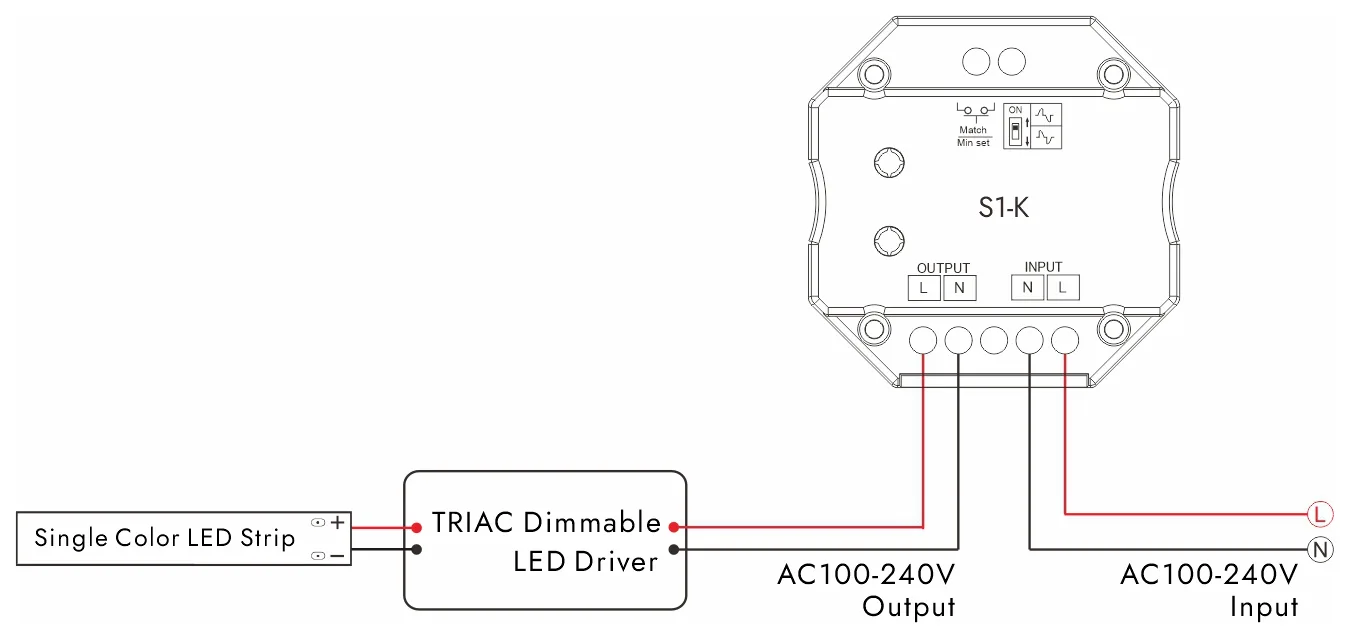
Triac dimming is a physical dimming method that chops the input voltage starting from the zero-crossing point of the AC waveform, with voltage only applied once the triac driver conducts. Its principle involves cutting the input voltage waveform through the conduction angle to produce a tangential output voltage waveform. By applying the tangential principle, the effective value of the output voltage is reduced, thereby lowering the power consumption of standard resistive loads.
Historically, TRIAC dimming technology was primarily used for standard and compact fluorescent lamps. However, TRIAC dimming technology has long been integrated into TRIAC dimming LED drivers, making it equally well-suited for LED lighting applications.

How TRIAC Dimming Works
The core principle of TRIAC dimming is phase-cut dimming. By altering the timing of the TRIAC’s conduction within the AC waveform, the dimmer effectively controls the electrical energy reaching the lamp, thereby adjusting brightness.
1. Phase-Cut Voltage Waveform
AC power operates at 50Hz or 60Hz cycles, producing a sinusoidal voltage waveform. Instead of continuously reducing voltage, the TRIAC dimmer minimizes energy by delaying conduction:
- Remains off during the first half of the voltage cycle;
- Conducts after reaching the preset trigger angle;
- Allows current flow for the remainder of the waveform.
Thus, shorter conduction duration delivers less effective energy to the lamp, resulting in reduced light intensity.
Illustrative examples:
- When triggering occurs near the waveform start → Higher energy received by the lamp → Higher brightness.
- When triggering is delayed to the latter part of the waveform → Reduced energy received by the lamp → Lower brightness.

2. Differences Between Leading-Edge and Trailing-Edge Trimming
Leading-Edge Trimming: Cuts off current at the beginning of the waveform, commonly found in traditional TRIAC dimmers. Disadvantage: Rapid current rise can cause impact on LED drivers.
Trailing Edge: Cuts off current at the end of the waveform. More suitable for electronic drivers, providing smoother and quieter dimming.
3. Implementation in LED Drivers
Unlike incandescent bulbs, LEDs do not directly respond to AC power. They rely on drivers to convert AC into stable DC.
When connected to a TRIAC dimmer, the LED driver must recognize the “cut” voltage waveform and convert it into the corresponding DC output.

This is why selecting a TRIAC-compatible driver is essential. Otherwise, the following issues may occur:
- Light flickering
- Inability to dim to low levels
- Buzzing noise from the fixture
- Dimmer overheating or failure
TRIAC dimming does not achieve reduced brightness by “directly lowering voltage,” but rather by indirectly reducing energy through “trimming the conduction time of the AC waveform.” While this method is inherently compatible with incandescent bulbs, LEDs require specially designed drivers to “interpret” these waveform changes and deliver stable dimming performance.
TRIAC Dimmers: Types and Features
With technological advancements, TRIAC dimming drivers have become compatible with LED lighting, emerging as one of the most popular dimmer types. In LED lighting systems, the TRIAC dimmer serves as the core component for implementing phase-cut dimming.
A TRIAC dimmer is an electronic device that utilizes a TRIAC to control high voltage and high current, thereby adjusting light brightness. It functions as an electronic switch that adjusts brightness by altering the power delivered to the light.
Based on design principles and output characteristics, common TRIAC dimmers can be categorized into two main types:
Traditional Manual TRIAC Dimmers
Traditional manual TRIAC dimmers are typically designed as wall-mounted units, available in either rotary knob or sliding dimmer configurations.
Why use manual TRIAC dimmers? Their simplicity makes them affordable. Installation and maintenance are as straightforward as standard light switches, with no concerns about Wi-Fi or batteries.
The drawbacks of manual TRIAC dimmers are their lack of automation and potential issues with LEDs not designed for dimmable lighting.
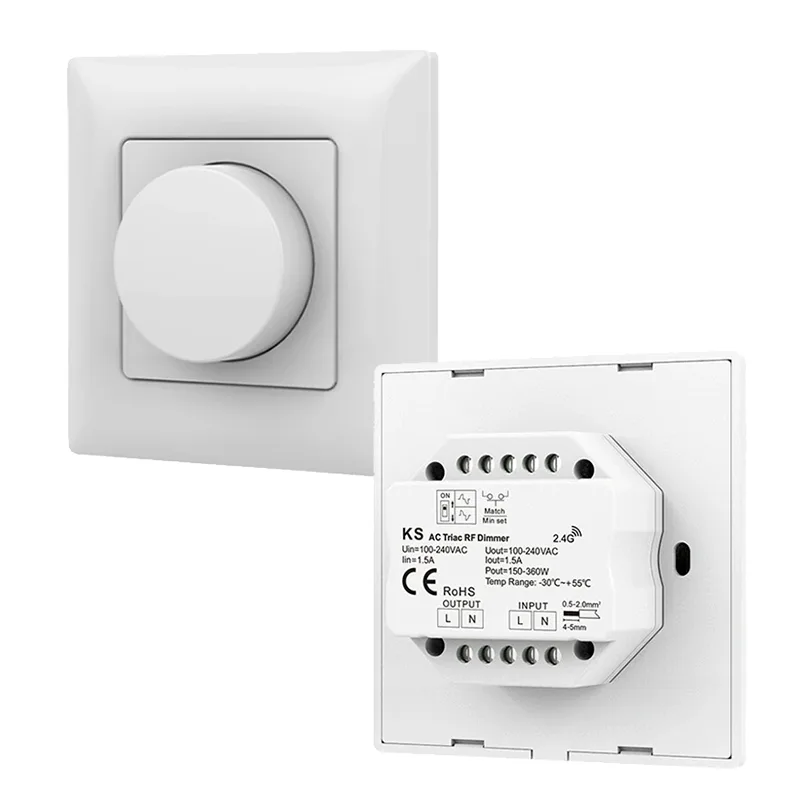
Ingangsspanning: AC100-240V
Output Voltage: AC100-240V
Output Current: Max. 1.5A
Output Power: 150-360W
Certification: CE, FCC
Size: L86 x W86 x H48mm
IP-classificatie: IP20
Garantie: 5 jaar
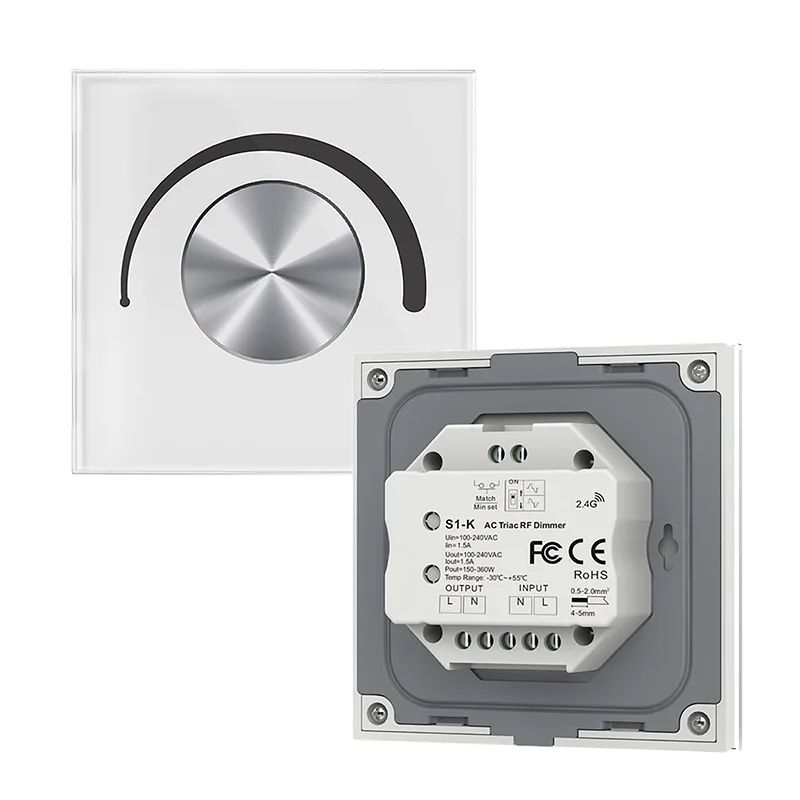
Ingangsspanning: AC100-240V
Output Voltage: AC100-240V
Output Current: Max. 1.5A
Output Power: 150-360W
Dimming Gray Scale: 256levels
Dimming Range: 0-100%
Certification: CE, FCC
Size: L86 x W86 x H48mm
IP-classificatie: IP20
Garantie: 5 jaar
Smart/Digital TRIAC Dimmers
As dimming technology advances, we now have remotely controllable smart TRIAC dimming systems and dimmers. Smart/digital TRIAC dimming provides a complete AC TRIAC control system, including TRIAC dimmers and switches, TRIAC-dimmable LED drivers, and DMX512 TRIAC dimmers.
Digital dimming systems require installing a dedicated app on iOS or Android devices. The WiFi signal is then converted to RF signals via a WiFi-to-RF converter, enabling control of the triac dimmer. Various RF dimming remote controls can be paired for convenient lighting control anytime, anywhere.
Additionally, monochromatic dimmable LED lights can be switched on/off and dimmed via panel knobs, panel touch buttons, wireless dimming remotes, DMX512 consoles, or DALI master controllers.
The smart triac dimmer incorporates a high-performance MCU, enabling 256-level smooth and precise dimming from 0% to 100%. Users can select leading-edge or trailing-edge dimming and set minimum brightness levels.
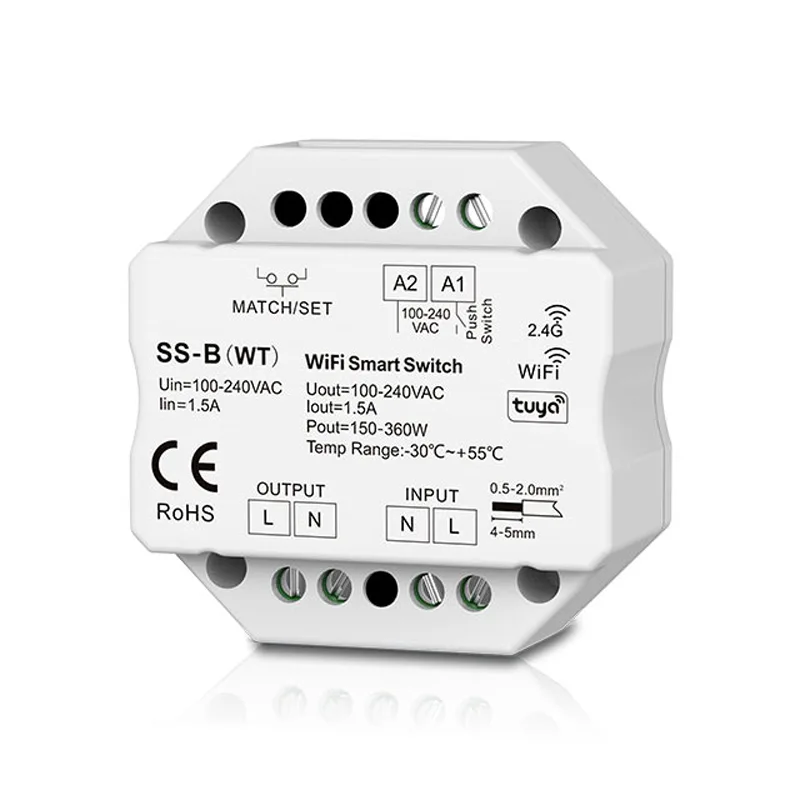
Ingangsspanning: AC100-240V
Output Voltage: AC100-240V
Output Current: Max. 1.5A
Output Power: 150-360W
Input Signal: WiFi +RF + Push Dim
Control Distance: 30m(Barrier-free space)
Certificering: CE, ROHS
Size: L60 x W60 x H40mm
IP-classificatie: IP20
Garantie: 5 jaar
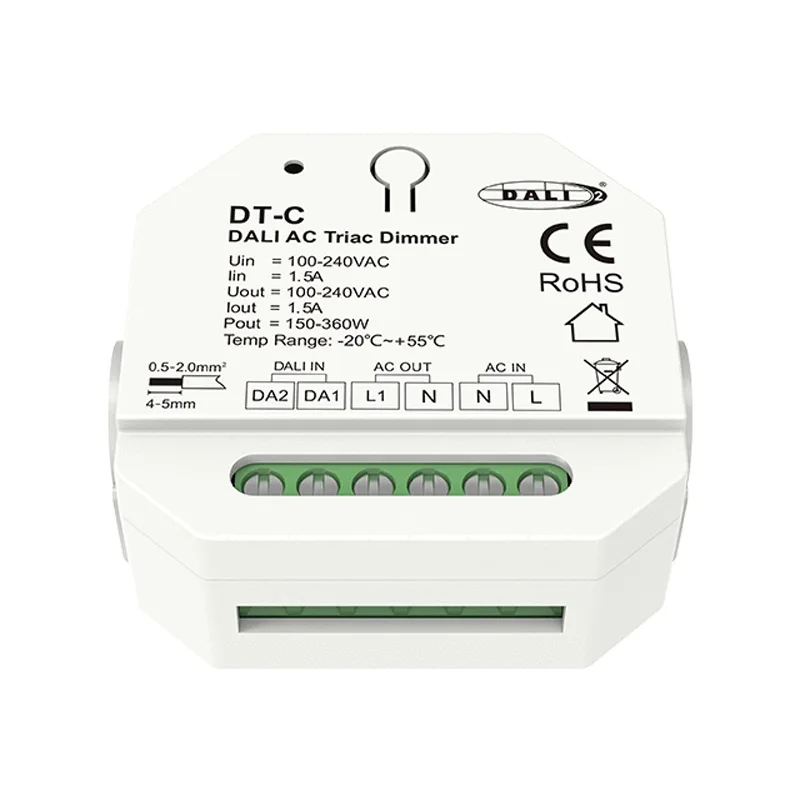
Ingangsspanning: AC100-240V
Output Voltage: AC100-240V
Output Current: Max. 1.5A
Output Power: 150-360W
Input Signal: DALI + AC Push
Dimming Gray Scale: 256levels
Dimming Range: 0-100%
Certificering: CE, ROHS
Size: L60 x W60 x H40mm
IP-classificatie: IP20
Garantie: 5 jaar
Key Characteristics Affecting TRIAC Dimmer Performance
In practical projects, beyond the dimming method itself, the following characteristics directly determine the dimmer’s performance:
1. Dimming Range
- High-quality dimmers achieve smooth transitions from 100% → 0%.
- Low-end products may only manage 100% → 30%.
2. Minimum Load Requirement
- Traditional TRIAC dimmers typically require a minimum load of ≥ 40W.
- With low-power LED lamps (e.g., 5W, 10W), issues like failure to fully illuminate or flickering may occur.
3. Compatibility
- Matching the dimmer with the driver is critical for system stability.
- Even drivers from the same brand but different models may require testing.
4. Dimming Curve and User Experience
- High-quality dimmers provide near-linear brightness transitions.
- Inferior products may exhibit “minimal change in the first half, then sudden dimming in the latter half.”
Selecting the appropriate TRIAC dimmer requires consideration of dimming mode (manual/smart/leading-edge/trailing-edge), power range, minimum load, and compatibility with LED drivers. For engineering projects, leading-edge dimmers suit cost-sensitive retrofits, while trailing-edge dimmers are better suited for high-quality lighting and long-term applications.
TRIAC-Compatible LED Drivers
In LED lighting systems, LED drivers are critical for stable power supply and dimming control. Since LEDs are DC devices, the AC waveform cut by TRIAC dimmers must be processed by specially designed TRIAC-compatible LED drivers to be correctly recognized and converted. If the driver is incompatible with TRIAC, dimming often results in flickering, inability to reduce brightness, or even luminaire damage.
1. Why are TRIAC-compatible drivers necessary?
- Waveform recognition capability: Standard constant-current drivers cannot accurately interpret chopped AC voltage. TRIAC-compatible drivers incorporate control circuits that map waveform changes to output current, enabling smooth dimming.
- Minimum load optimization: For low-power LED fixtures, the driver adjusts the input circuit to prevent flickering or failure to start due to insufficient current.
- Noise and overheating prevention: Some drivers produce inductive chatter (buzzing) when receiving phase-cut signals. High-quality TRIAC drivers resolve this through filtering and optimized circuit design.
2. Driver Types: Constant Voltage vs. Constant Current
Constant Voltage (CV) Drivers: Output a fixed voltage (e.g., 12V, 24V), suitable for LED strips, low-voltage LED modules, etc. Dimming typically relies on PWM or current modulation.
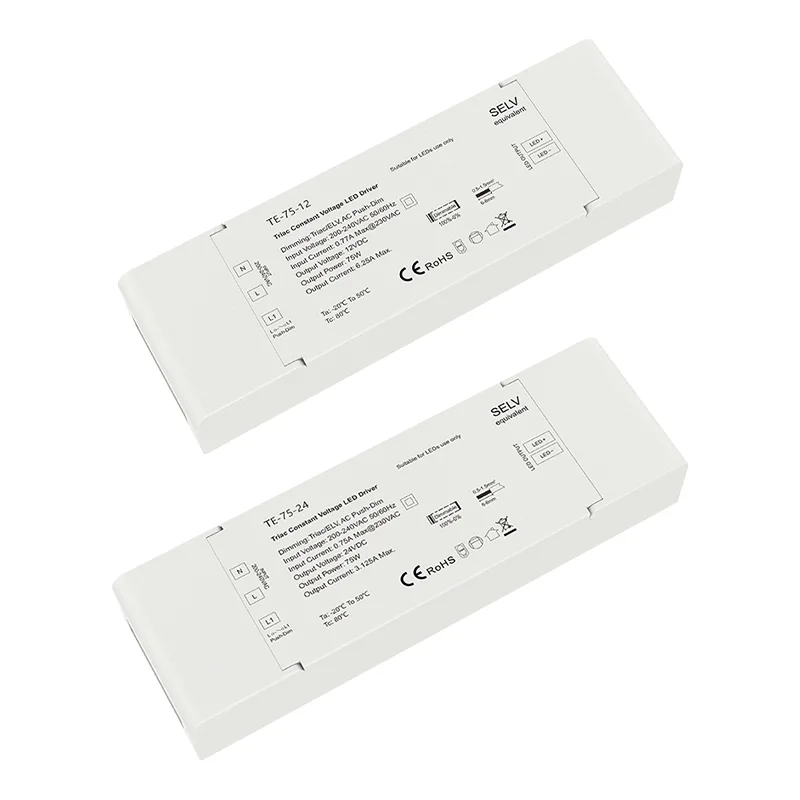
Model: TE-75-12, TE-75-24
Uitgangsspanning: DC12V/24V
Output Current: 6.25A/3.125A
Output Power: 75W
Dimming Range: 0-100%
Dimming Interface: Triac/ELV, AC Push-Dim
Input Voltage: AC200-240V
Efficiency: 85%-87%
Certificering: CE, ROHS
Size: L179 x W56 x H30mm
IP-classificatie: IP20
Garantie: 5 jaar
Constant Current (CC) Driver: Outputs a constant current (e.g., 350mA, 700mA), suitable for LED downlights, spotlights, LED panel lights, etc. Requires more precise current control and higher compatibility standards.
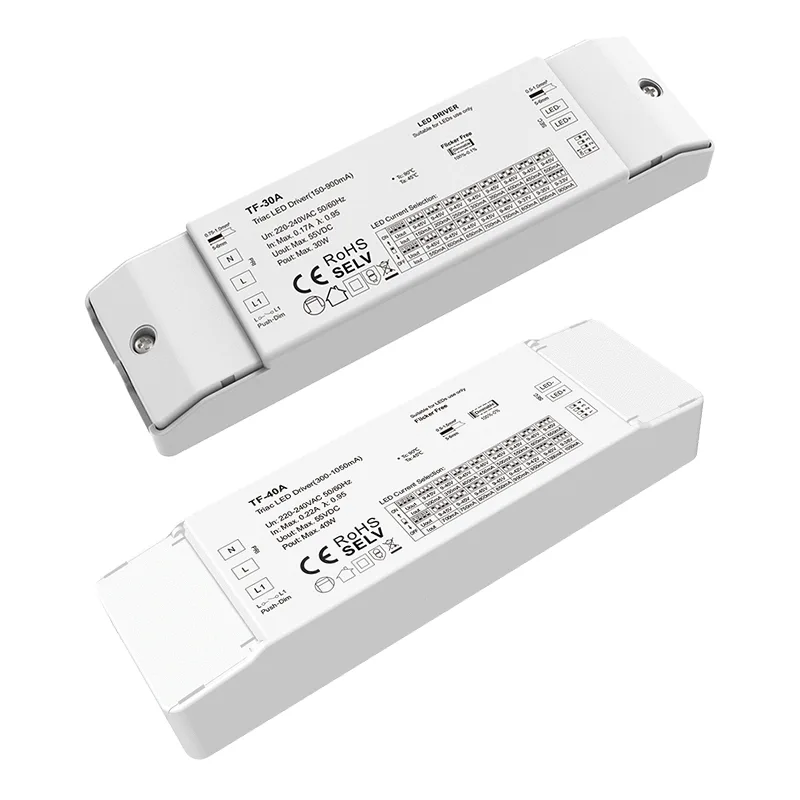
Model: TF-40A, TF-30A
Output Voltage: DC9-45V
Output Current: 300-1050mA/150-900mA
Output Power: 40W/30W
Dimming Range: 0-100%
Dimming Interface: Triac/ELV, AC Push-Dim
Input Voltage: AC200-240V
Efficiency: 84%-85%
Certificering: CE, ROHS
Size: L149 x W45 x H24mm
IP-classificatie: IP20
Garantie: 5 jaar
In practical projects, constant current drivers demand higher TRIAC compatibility, so brand reputation and test results must be prioritized during selection.
3. Selection Criteria
When purchasing TRIAC-compatible drivers, project managers should focus on the following parameters:
- Dimming Range: Supports smooth dimming from 100% to 5% or lower.
- Power Factor (PF): Recommended ≥0.9 to ensure efficiency and stability.
- Compatibility List: High-quality driver manufacturers typically provide compatibility test reports for common dimmers.
- THD (Total Harmonic Distortion): Low THD designs minimize grid interference, making them suitable for commercial and hospitality lighting.
- Certification Standards: UL, CE, ENEC, and other certifications are particularly critical for export projects.
4. Practical Application Considerations
- Low-power fixtures (e.g., downlights, spotlights) → Back-cut drivers recommended for more stable dimming.
- LED strips and linear lights → Typically use constant-voltage drivers; verify compatibility with common dimmers.
- Large-scale commercial projects → Conduct sample testing beforehand to avoid increased maintenance costs from batch incompatibility later.
TRIAC LED drivers are essential for ensuring stable operation of LED fixtures in traditional dimming systems. For project stakeholders, selecting the appropriate driver not only minimizes flickering and noise issues but also reduces after-sales costs while enhancing the overall lighting experience.
Advantages of TRIAC Dimming
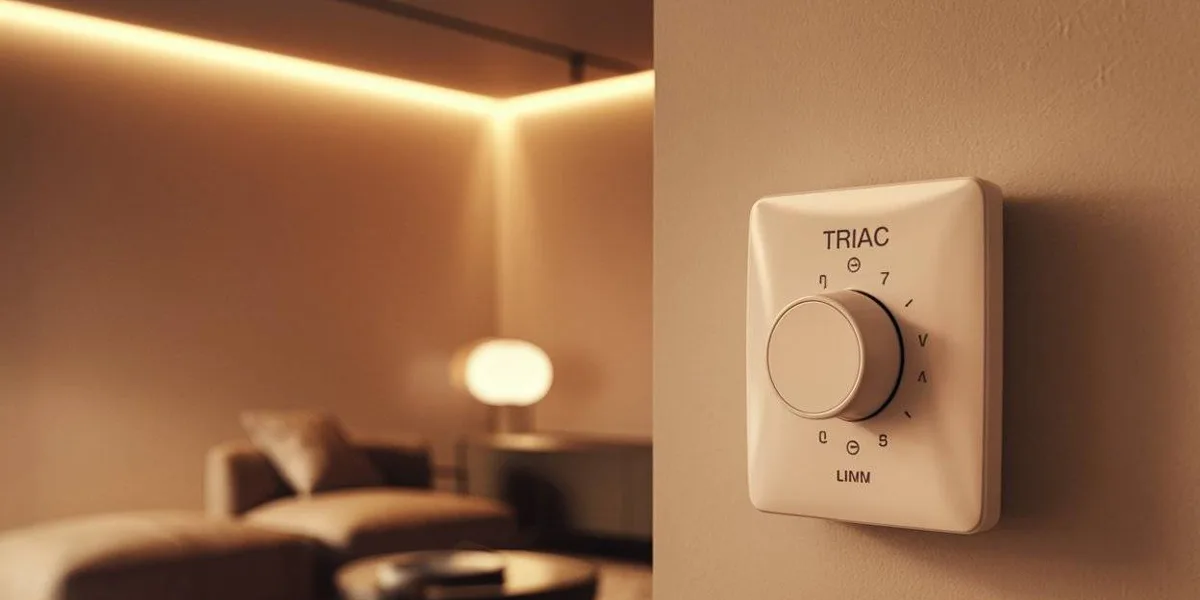
Although increasingly advanced digital dimming protocols (such as 0-10V, DALI, and smart wireless control) are available on the market today, TRIAC dimming remains widely adopted globally. This is primarily due to the following advantages:
1. Extensive Market Base and Compatibility
In European and American markets, TRIAC dimming remains the mainstream choice for residential lighting. Having been in use for decades, TRIAC dimmers are already installed in nearly all traditional buildings, homes, and commercial spaces.
For retrofit projects in older buildings, using TRIAC LED drivers enables seamless upgrades without replacing existing dimmers.
2. Cost Advantage
Compared to digital dimming systems like DALI or 0-10V, TRIAC dimming requires no additional control wiring, relying solely on a standard AC power supply. Moreover, the dimmers themselves are inexpensive, and the additional cost of the drivers is relatively low.
Therefore, for most small- to medium-sized projects, TRIAC offers the highest cost-performance ratio among dimming solutions.
3. Simple Installation
TRIAC dimming employs a two-wire wiring system, nearly identical to standard switch circuits, eliminating the need for additional signal wires. This allows electricians and installers to quickly get up to speed, reducing construction complexity. For locations with existing wiring, retrofitting requires minimal rewiring.
4. Intuitive User Experience
Traditional knob-style or slider-style dimmers offer intuitive operation that users easily understand and operate. Compared to DMX/DALI digital control systems, TRIAC dimmers typically require no programming or additional configuration, offering true plug-and-play functionality.
5. System Stability
Years of application have proven TRIAC dimming to be highly reliable in residential and small commercial spaces. Moreover, high-quality trailing-edge TRIAC dimmers provide near-linear dimming curves, meeting most comfort requirements.
The core advantages of TRIAC dimming lie in its “low cost + high compatibility + easy installation.” This makes it highly suitable for retrofitting existing buildings, residential lighting, and small-to-medium commercial projects. It remains the preferred solution, especially in scenarios where client budgets are limited but basic dimming functionality is still desired.
Limitations and Common Issues
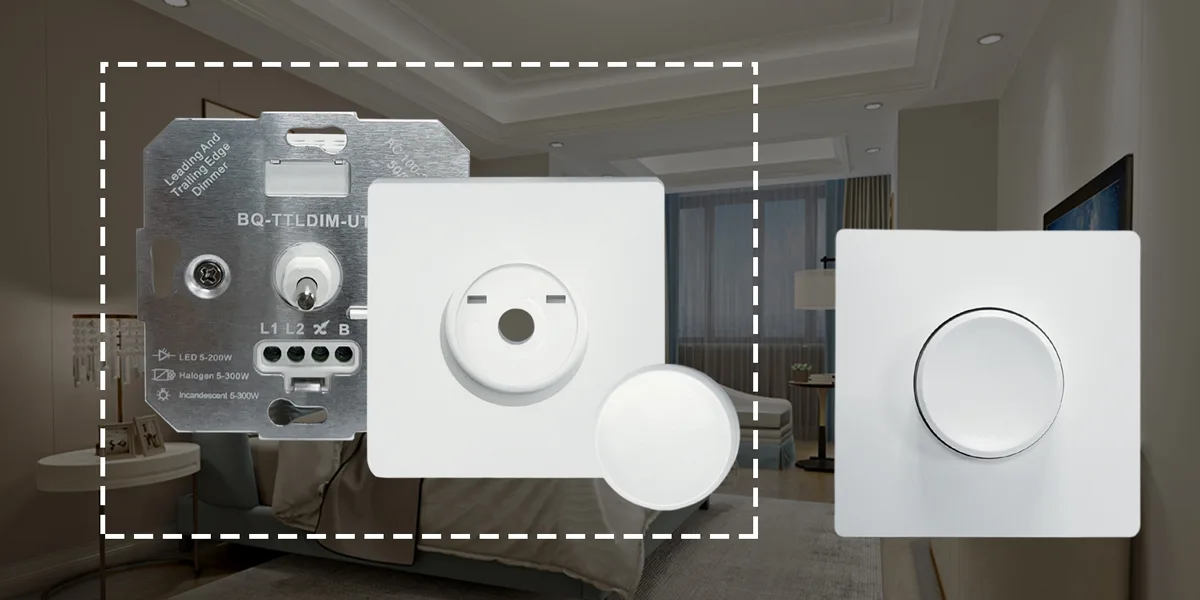
While TRIAC dimming offers clear advantages in cost and compatibility, it also presents notable limitations and potential issues in modern LED lighting applications.
1. Compatibility Issues
- Not all LED drivers support TRIAC: Standard drivers may fail to recognize the chopped waveform, resulting in dimming failure or abnormal operation.
- Variations between brands: Even drivers labeled as TRIAC-compatible may not fully match all dimmers.
- Batch project risks: In large-scale deployments, insufficient testing may result in some fixtures functioning normally while others flicker.
2. Limited Dimming Range
Most TRIAC systems struggle to achieve full-range dimming from 100% to 0%. Common lower limits are around 10%–30%, failing to meet the low-light requirements of certain high-end hotels, theaters, or exhibition spaces.
3. Flicker and Instability
Flicker is particularly pronounced at low brightness levels due to the physical differences between LEDs and incandescent bulbs. Poor-quality LED drivers may exhibit slight flicker even at full brightness. Additionally, unstable waveforms can interfere with camera recordings (video flicker issues).
4. Noise Issues
Certain LED drivers or fixtures produce a humming sound (inductive vibration) under TRIAC dimming. This is particularly noticeable in quiet indoor spaces like hotel rooms or high-end residences, significantly impacting the experience.
5. Power Limitations
Traditional TRIAC dimmers impose minimum power requirements on loads (typically ≥ 40W). For low-power LED fixtures (5W, 10W), they may fail to start or dim properly.
Since each TRIAC LED dimmer has a power limit (typically 150W-360W), exceeding this limit may cause:
- oververhitting: Leading to dimmer failure or fire hazards.
- Poor performance: Uncontrolled flickering or unresponsive operation.
- Reduced lifespan: Damage to both the dimmer and the light fixture.
Therefore, when connecting multiple LED fixtures in parallel, ensure the total power does not exceed the dimmer’s upper limit.
6. Uneven Dimming Curve
Some low-cost TRIAC dimmers exhibit nonlinear brightness changes. Users may perceive minimal brightness adjustment in the initial phase, followed by a sudden drop in the latter phase, compromising the dimming experience.
Key issues with TRIAC dimming include compatibility, dimming range, flicker, and noise. For projects demanding high-quality lighting (e.g., premium commercial spaces, exhibitions, film/TV production sites), TRIAC may not be the optimal choice. Therefore, when selecting a TRIAC dimming solution, pre-testing driver-dimmer compatibility is crucial to prevent future problems and reduce maintenance costs.
Troubleshooting and Best Practices
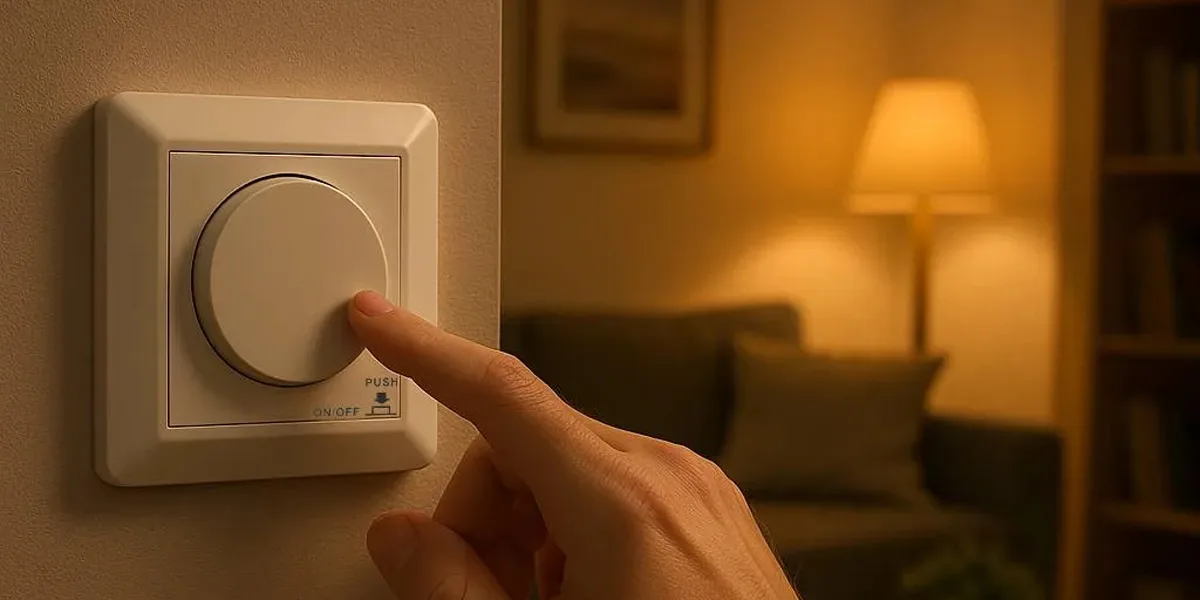
In practical applications, while TRIAC dimming has reached relative maturity, common issues may still arise due to its phase-cut control method. Through proper troubleshooting and adherence to best practices, system stability and dimming performance can be significantly enhanced.
Common Issues and Solutions
1. Light Flickering
Causes: Incompatibility between the LED driver and the TRIAC dimmer; insufficient load power failing to meet the dimmer’s minimum load requirement; mains voltage fluctuations.
Oplossingen:
- Use TRIAC-compatible LED drivers (labeled as leading-edge or trailing-edge compatible).
- Increase the load or select a low-power compatible dimmer.
- Incorporate anti-interference filter circuits into the system.
2. Non-Smooth Dimming
Causes: Insufficient dimmer resolution or mismatch between the LED driver’s dimming curve and the dimmer.
Oplossingen:
- Select a high-quality dimmer supporting deep dimming (100%-0%).
- Use programmable or optimized LED drivers to improve low-end brightness linearity.
3. Failure to Turn On
Cause: Some TRIAC dimmers require a minimum operating current, while the LED fixture’s power is too low.
Oplossingen:
- Check and ensure the fixture’s total power ≥ the dimmer’s minimum load requirement.
- Consider switching to an electronic dimmer designed for low-power LEDs.
4. Buzzing Noise
Cause: Mechanical vibration from internal components during current switching; poor compatibility between driver and dimmer.
Oplossing:
- Use a high-quality dimmer with a low-noise design.
- Replace with a more compatible LED driver.
Best Practices
Proper selection and maintenance of your TRIAC dimmer ensures optimal performance and extended lifespan. Follow these best practices for long-term reliability:
1. Compatibility Matching
Prioritize confirming compatibility between LED drivers and TRIAC dimmers during design and procurement to avoid frequent replacements.
If compatibility is uncertain, opt for trailing-edge dimmers, which generally offer better compatibility with LED drivers than leading-edge types.
2. Maintain Suitable Load
TRIAC dimmers often require a minimum load (e.g., 20W-40W). For low-power applications, this can be addressed by adding a parallel compensation circuit.
3. Conduct Field Testing
Compatibility may vary between different brands and models of LED fixtures and dimmers. Before bulk deployment, test multiple samples in the actual grid environment to ensure compatibility and stability.
4. Prioritize Certified Products
Select dimmers and drivers compliant with certifications like UL or CE to minimize issues caused by electromagnetic interference or unstable quality.
5. Installation and Wiring Standards
Maintain tidy wiring, and avoid sharing circuits with high-power equipment to minimize electromagnetic interference. For long-distance cabling, add EMI filtering or surge protection measures as needed.
6. Regular Cleaning and Inspection
Turn off power before cleaning. Use a dry cloth to wipe the dimmer switch and remove dust or grime. Inspect for loose screws or exposed wires, which may cause flickering.
By correctly identifying common issues, selecting compatible products, and adhering to best practices for installation and commissioning, TRIAC dimming systems not only deliver stable and reliable dimming performance but also extend the lifespan of LED fixtures and drivers, offering superior cost-effectiveness for projects.
TRIAC vs. Other Dimming Methods
In the realm of LED dimming, TRIAC is not the only solution. Different dimming methods each have their advantages and limitations. Selecting the appropriate technology requires consideration of the application scenario, cost budget, and luminaire compatibility.
The table below provides a detailed comparison between TRIAC and common dimming methods such as 0-10V, PWM, and DALI.
| Comparison Item | driekwart | 0-10V | Pwm | DALI / Digital Protocol |
| Werkingsprincipe | Cuts AC voltage by phase-cutting to alter input power | Controls LED drive current via DC voltage signal (0-10V) | Adjusts brightness by modifying duty cycle through Pulse Width Modulation (PWM) | Enables individual addressing and control of luminaires via bidirectional digital communication protocol |
| Wiring Requirements | No additional control wires required; directly replaces switches | Requires two additional control wires | Typically requires dedicated control wires or controllers | Requires dedicated bus wiring (two control wires) |
| Installation & Retrofit | Simplest; directly replaces traditional dimmers | Requires additional wiring; suitable for new construction | Depends on control system; moderate complexity | Complex installation and commissioning; requires professionals |
| Dimming Performance | Curve less smooth; unstable low-end brightness | Smooth dimming with excellent low-level performance | Excellent linear dimming, enabling deep dimming (<1%) | Precise, smooth, programmable control with scene support |
| Compatibiliteit | Limited by LED drivers, prone to flicker/noise | High compatibility with most LED drivers | Compatibility with RGB/RGBW, suitable for dynamic lighting | Highly compatible, supports multi-vendor interoperability |
| Intelligence Level | Low, no remote or group control | Moderate, supports zone dimming | Moderate-high, integrates with smart controllers | Highly intelligent, supports grouping, auto-adjustment, and bidirectional communication |
| Kosten | Lowest, inexpensive dimmers | Moderate, increased wiring and driver costs | Moderate, higher control system investment | Highest, requires complete systems including controllers and gateways |
| Typische toepassingen | Residential homes, hotel rooms, small retail spaces, retrofit projects | Commercial lighting, new buildings, office environments | Stage lighting, landscape illumination, RGB dynamic lighting | Large-scale smart lighting projects in office towers, hotels, airports, hospitals, etc. |
TRIAC vs. 0-10V Dimmen
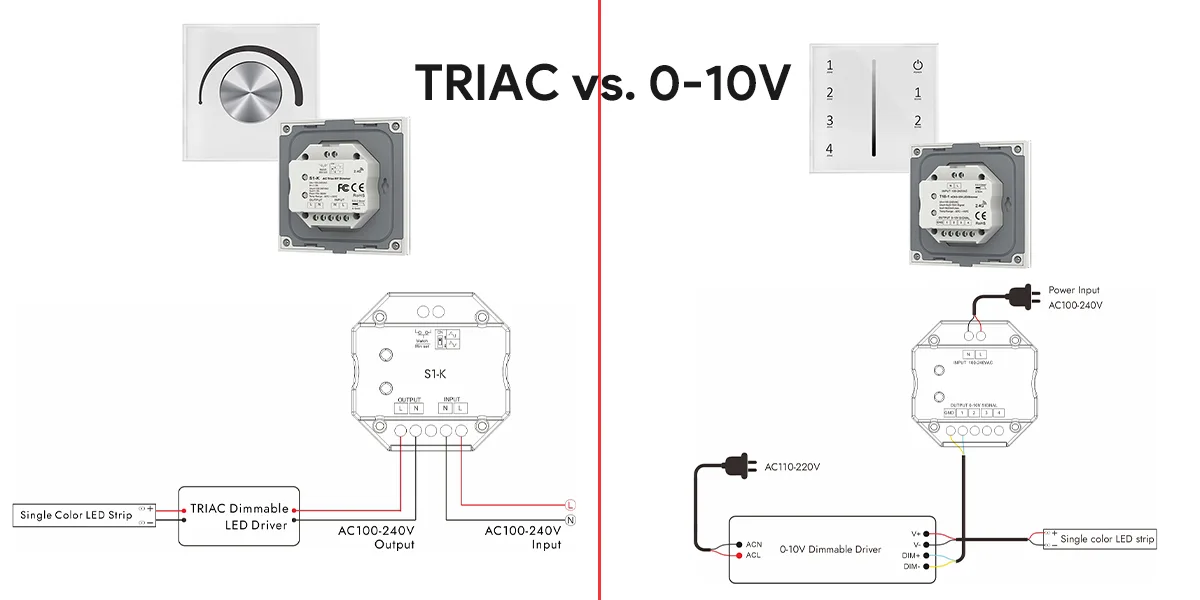
Both 0/1-10V dimming and TRIAC dimming are common physical dimming methods and analog dimming techniques. Their distinctive feature lies in the driver having two ports: +10V and -10V.Standard TRIAC dimmers typically feature only one port serving both +10V and -10V functions.
0-10V dimming achieves control by regulating the current output from the LED driver. Here, 0V represents complete darkness, while 10V signifies full brightness. For instance, in a resistive dimmer, a voltage of 1V corresponds to 10% current. At 10V, the current reaches 100%.
1. Working Principle:
- TRIAC controls power input by phase-cutting AC voltage.
- 0-10V controls the LED driver output current by sending a DC signal ranging from 0V (lights off) to 10V (full brightness).
2. Advantage Comparison:
- TRIAC: Simple wiring, can directly replace traditional dimming systems, suitable for retrofit projects.
- 0-10V: Smooth dimming with high control precision, excelling particularly at low brightness levels.
3. Disadvantages Comparison:
- TRIAC: Non-linear dimming curve and compatibility issues.
- 0-10V: Requires additional control wiring, resulting in higher installation costs.
4. Application Scenarios:
- TRIAC: Better suited for simple retrofits in residential and small-to-medium commercial spaces.
- 0-10V: Commonly used in new construction projects and commercial lighting requiring large-scale zone control.
TRIAC vs. PWM Dimming
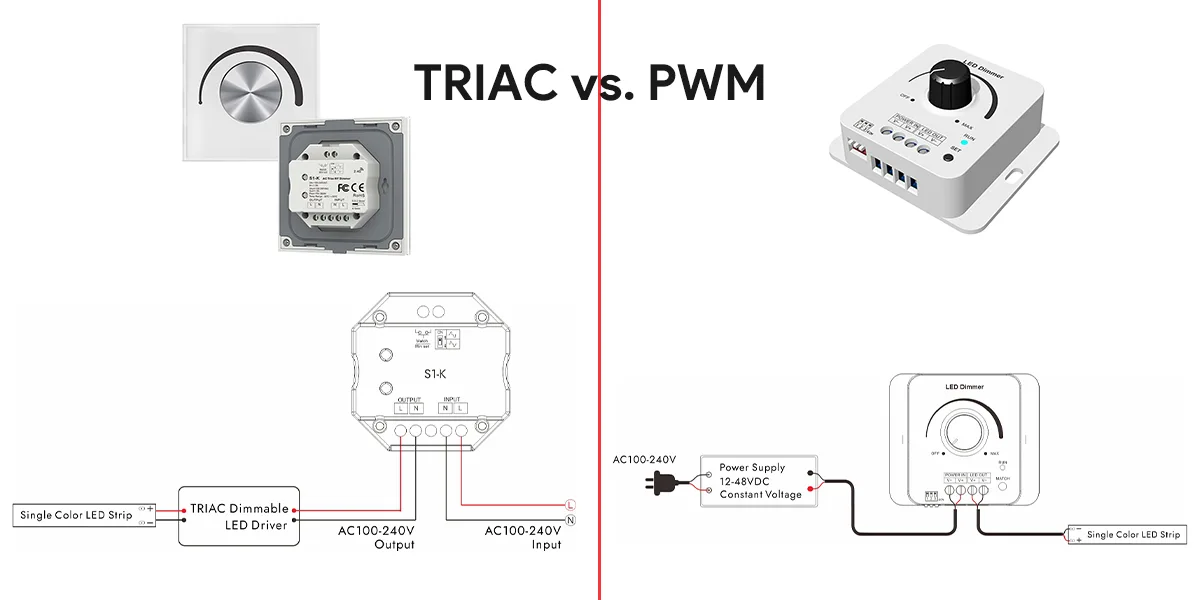
PWM (Pulse Width Modulation) is a new method that uses digital computer outputs to control analog systems, serving as a digital dimming technique.
It achieves dimming by controlling the ratio of on-time to off-time for LED lights. PWM dimming is implemented by installing a DC PWM dimmer between the LED strip and the standard power supply to regulate the LED brightness.
Due to the fast response speed of LEDs, high-frequency PWM dimming can be achieved, resulting in a more uniform and stable dimming effect. Therefore, PWM dimming is primarily used for LED lights and LED strips, enabling precise control over LED brightness.
While TRIAC dimming can also smoothly adjust the current signal to achieve a more natural dimming effect, it regulates current by controlling the TRIAC component in the circuit. Consequently, its dimming precision is lower, allowing only simple brightness adjustment.
1. Working Principle:
- TRIAC: Cuts the voltage waveform at the AC input terminal.
- PWM (Pulse Width Modulation): Adjusts brightness by altering the duty cycle through high-speed switching of the LED driver output.
2. Advantage Comparison:
- TRIAC: Requires no additional control system, low cost.
- PWM: Excellent dimming linearity, enables deep dimming (down to 1% or lower), and supports RGB/RGBW dynamic control.
3. Disadvantage Comparison:
- TRIAC: Unstable low-level dimming, potential color temperature drift.
- PWM: May exhibit flicker if improperly designed (undesirable for photography and visually sensitive applications).
4. Suitable Scenarios:
- TRIAC is suitable for cost-sensitive residential lighting.
- PWM is preferred in stage lighting, landscape illumination, and smart control systems.
TRIAC vs. DALI/Digital Protocols Dimming
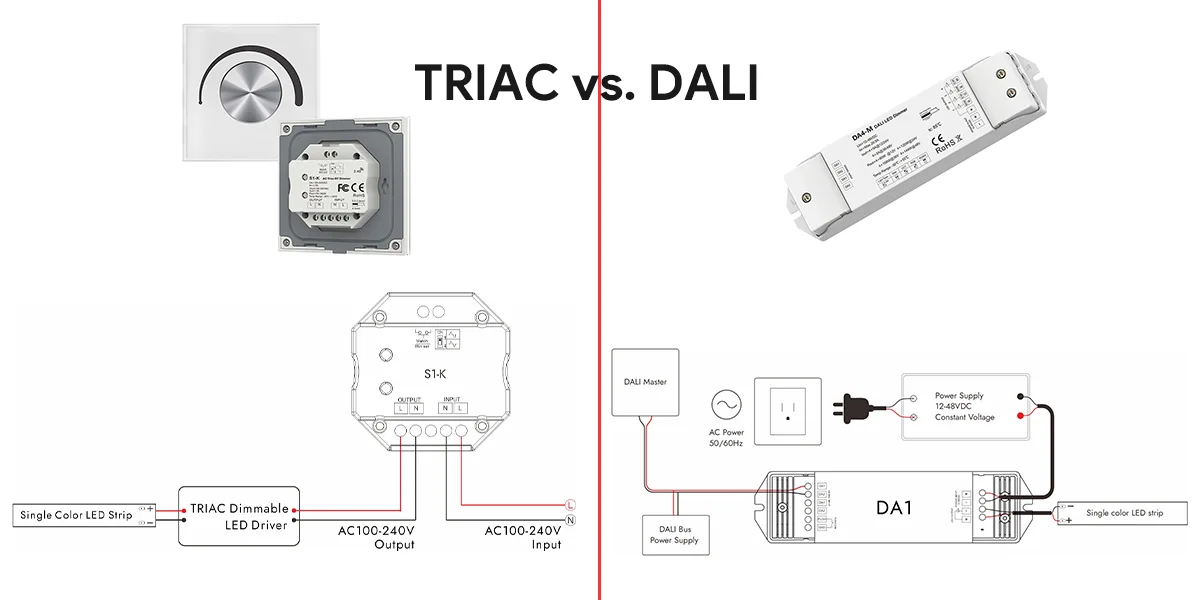
DALI dimming requires two bus wires connected to each DALI driver. After basic setup, advanced lighting control systems enable rule-based modifications to lighting circuits. DALI lighting provides full brightness control over light sources like LED strips, LED downlights, and LED spotlights.
DALI’s unique advantage lies in its superior dimming range, outperforming other modern dimming methods. Furthermore, the application scope of new DALI technology continues to expand, making it highly suitable for managing RGBW and adjustable white light fixtures. If you require extremely precise adjustments to light and color, DALI-standard dimming components are the optimal choice.
1. Working Principle:
- TRIAC: Relies on analog voltage control (phase-cutting).
- DALI (Digital Addressable Lighting Interface): Utilizes a bidirectional digital communication protocol, enabling individual addressing, programming, and control of each luminaire.
2. Feature Comparison:
- TRIAC: Lowest cost, simple installation, suitable for small-scale systems.
- DALI: Most powerful functionality, supports grouping, scenes, and automatic adjustments (e.g., with sensors), highly suitable for smart buildings and large commercial lighting.
3. Drawback Comparison:
- TRIAC: Traditional TRIACs lack zoning and remote control capabilities, offering limited intelligence.
- DALI: Higher system cost with complex wiring and commissioning.
4. Application Scenarios:
- TRIAC is used for residential or small-to-medium retrofits;
- DALI is widely deployed in projects demanding high lighting intelligence, such as office buildings, hotels, and airports.
Applications of TRIAC Dimming
TRIAC dimming offers extensive value in residential, commercial, and retrofit projects due to its low cost, convenience, and compatibility with traditional electrical systems. While it may not match DALI or 0-10V in smart lighting and large-scale control applications, it remains one of the preferred solutions for residential lighting and small-to-medium commercial lighting.
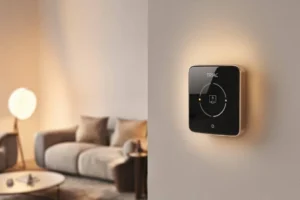





1. Residential Lighting
Primary Requirements: Comfortable lighting environments, energy efficiency, and ease of operation.
Application Scenarios: Living rooms, bedrooms, dining areas, etc., where brightness is easily adjusted via wall knobs or touch switches.
Advantages: Requires no additional wiring; users can directly replace existing incandescent/halogen dimmers to quickly enable LED dimming.
2. Small Commercial Spaces
Primary Needs: Cost control and ambiance creation.
Application Scenarios: Cafes, restaurants, retail stores, etc., utilizing TRIAC dimming to create lighting atmospheres for different time periods.
Advantages: Low investment cost, easy maintenance, suitable for rapid deployment in small to medium-sized projects.
3. Hotels & Hospitality
Primary Needs: Delivering comfortable, adjustable lighting environments to enhance guest experience.
Application Scenarios: Hotel guest rooms, corridors, restaurants, and lounge areas.
Advantages: Dimmers integrate into existing wall switch systems without requiring additional control systems, reducing wiring complexity.
4. Retrofit Projects
Primary Needs: Upgrading lighting equipment while retaining existing electrical systems.
Application Scenarios: LED retrofit projects in older residences, office buildings, and retail spaces.
Advantages: TRIAC dimming directly replaces existing dimmer switches with strong compatibility, significantly lowering retrofit costs compared to 0-10V or DALI systems.
5. Decorative & Mood Lighting
Primary Need: Create diverse atmospheres through flexible dimming.
Application Scenarios: Home theaters, bars, exhibition halls, churches, etc.
Advantages: Brightness adjustment achievable through simple phase-cutting without complex digital controls.
6. Auxiliary & Task Lighting
Primary Requirement: Enable illuminance adjustment for localized spaces.
Application Scenarios: Kitchen countertops, reading nooks, vanity lights, etc.
Advantages: Convenient adjustment allows users to flexibly modify light intensity based on usage needs.
Conclusie
TRIAC dimming, as a mature and economical dimming method, remains widely adopted globally due to its high compatibility with traditional electrical systems. Its advantages include:
- Low cost and simple wiring: Requires no additional control wires, making it suitable for residential and small commercial spaces;
- Renovation-friendly: Can directly replace dimming systems for incandescent or halogen lamps;
- Versatile application: Meets diverse lighting needs in residential, hospitality, dining, retail, and other settings.
However, TRIAC dimming also presents certain limitations:
- Less smooth dimming curves with limited low-end brightness control;
- Compatibility issues with LED drivers may cause flickering, noise, or other problems;
- Less flexible than 0-10V, PWM, or DALI in large-scale smart lighting control systems.
Overall, TRIAC dimming remains a highly suitable choice for projects prioritizing low-cost retrofits, ease of operation, and rapid deployment.
However, for projects demanding high-precision dimming, intelligent management, and large-scale lighting control, digital dimming protocols (such as 0-10V, DALI, or wireless control systems) offer superior advantages.
By correctly selecting compatible LED drivers and high-quality dimmers and adhering to best practices for installation and testing, TRIAC dimming can still deliver a stable, reliable, and cost-effective lighting experience for users.

